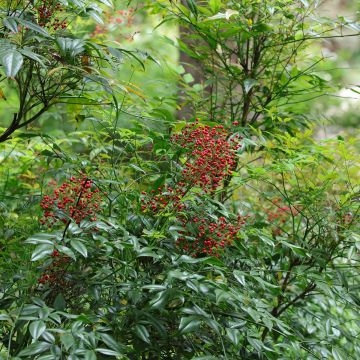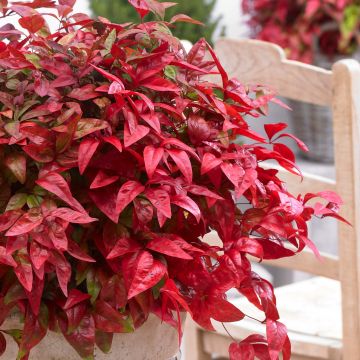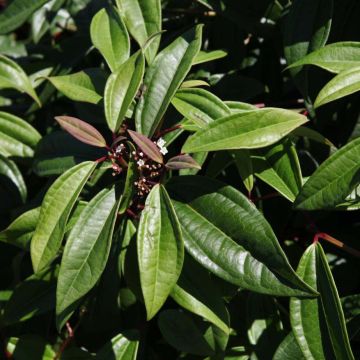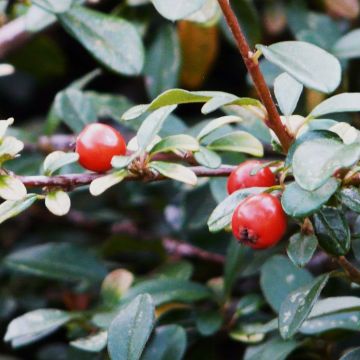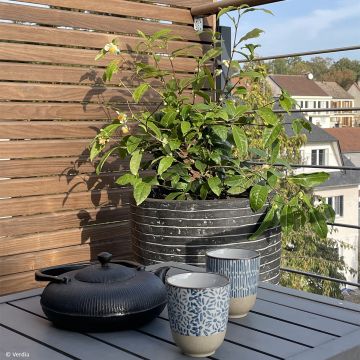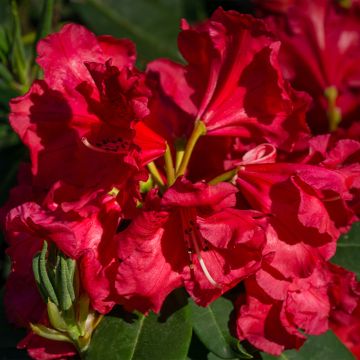

Nandina domestica Filamentosa - Sacred Bamboo
Nandina domestica Filamentosa - Sacred Bamboo
Nandina domestica Filamentosa
Sacred Bamboo, Heavenly Bamboo
Why not try an alternative variety in stock?
View all →This plant carries a 24 months recovery warranty
More information
We guarantee the quality of our plants for a full growing cycle, and will replace at our expense any plant that fails to recover under normal climatic and planting conditions.
From €5.90 for pickup delivery and €6.90 for home delivery
Express home delivery from €8.90.
Delivery to Corse prohibited: UE law prohibits the import of this plant from mainland France to Corse as part of the fight against Xylella fastidiosa. Please accept our sincere apologies.
More information

Does this plant fit my garden?
Set up your Plantfit profile →
Description
Nandina domestica 'Filamentosa', also known as Sacred Bamboo, is a recent horticultural variety that is small in size, with extremely fine, spider-like foliage that changes throughout the seasons from pink-orange in spring, to green-yellow in summer, to a beautiful red-purple to violet in autumn. The summer flowering, in panicles of small white flowers, often coincides with the intense red fruiting of the previous year. This unique and sculptural bush is ideal for small gardens, and will be a highlight of the garden in a large pot on a terrace.
'Filamentosa' belongs to the Berberidaceae family. It is a recently obtained cultivar from Nandina domestica native to India, China, and Japan. The growth of this small tree is quite slow and its adult size will not exceed 90cm (35in) in height and 1m (3ft) in width. 'Filamentosa' is a small bush with spreading foliage and upright stems resembling those of bamboo, as wide as it is tall. Its vegetation is dense, compact, and beautifully rounded. The plant is beautiful all year round. Its young pink-orange shoots then produce long, very narrow leaves that are deeply cut and have a beautiful green-yellow colour that turns red-purple in autumn. In June-July, it produces small conical panicles of cream-white flowers. These are followed by clusters of bright red, highly decorative fruits that persist for a long time on the branches, creating a joyful scene in the winter light. The root of this plant is a root stock.
Plant 'Filamentosa' in soft, deep, even slightly chalky, moderately dry to moist, well-drained soil. It prefers partial shade or sunny situations that are not scorching. Avoid drying winds and provide a location sheltered from severe cold. This bush is hardy down to -15°C (5°F), so it will be wise to protect its base with a thick layer of dead leaves before winter in colder regions. If the above-ground part were to freeze, the plant should be pruned back to ground level in February-March. Pruning is limited to removing dead wood and excess or weak branches in winter.
Nandina domestica 'Filamentosa' is particularly admirable in large plantings. It can be planted with choice shrub peonies, rudbeckia, Spiraea japonica 'Little Princess', Euphorbia griffithii 'Fire Glow', crocosmia, or daylilies. Each of these scenes will be a success. This small bush will also be magnificent in a large pot on a terrace, in a non-scorching exposure with regular watering. In a flowering hedge, it can be accompanied by Kolkwitzia amabilis, Viburnum tinus, Lespedeza thunbergii, or Abelia grandiflora.
Sacred Bamboo is related to berberis, and despite its common name, it has nothing to do with bamboo. It is its slender and upright habit and its spindle-shaped leaves that make it resemble bamboo. This bush, the only one of its kind, has been cultivated for centuries in Asia, planted around Taoist temples. Therefore, many varieties have emerged in Japan, and for many of them, the foliage modifications are due to diseases (viruses).
Report an error about the product description
Nandina domestica Filamentosa - Sacred Bamboo in pictures


Plant habit
Flowering
Foliage
Botanical data
Nandina
domestica
Filamentosa
Berberidaceae
Sacred Bamboo, Heavenly Bamboo
Cultivar or hybrid
Other Nandina
Planting and care
Plant 'Filamentosa' in soft, deep, even slightly chalky, moderately dry to moist, well-drained soil. It prefers partial shade or sunny situations that are not scorching. Avoid drying winds and provide a location sheltered from severe cold. This bush is hardy down to -15°C (5°F), so it will be wise to protect its base with a thick layer of dead leaves before winter in colder regions. If the above-ground part were to freeze, the plant should be pruned back to ground level in February-March. Pruning is limited to removing dead wood and excess or weak branches in winter.
Planting period
Intended location
Care
-
, onOrder confirmed
Reply from on Promesse de fleurs
Evergreen shrubs
Haven't found what you were looking for?
Hardiness is the lowest winter temperature a plant can endure without suffering serious damage or even dying. However, hardiness is affected by location (a sheltered area, such as a patio), protection (winter cover) and soil type (hardiness is improved by well-drained soil).

Photo Sharing Terms & Conditions
In order to encourage gardeners to interact and share their experiences, Promesse de fleurs offers various media enabling content to be uploaded onto its Site - in particular via the ‘Photo sharing’ module.
The User agrees to refrain from:
- Posting any content that is illegal, prejudicial, insulting, racist, inciteful to hatred, revisionist, contrary to public decency, that infringes on privacy or on the privacy rights of third parties, in particular the publicity rights of persons and goods, intellectual property rights, or the right to privacy.
- Submitting content on behalf of a third party;
- Impersonate the identity of a third party and/or publish any personal information about a third party;
In general, the User undertakes to refrain from any unethical behaviour.
All Content (in particular text, comments, files, images, photos, videos, creative works, etc.), which may be subject to property or intellectual property rights, image or other private rights, shall remain the property of the User, subject to the limited rights granted by the terms of the licence granted by Promesse de fleurs as stated below. Users are at liberty to publish or not to publish such Content on the Site, notably via the ‘Photo Sharing’ facility, and accept that this Content shall be made public and freely accessible, notably on the Internet.
Users further acknowledge, undertake to have ,and guarantee that they hold all necessary rights and permissions to publish such material on the Site, in particular with regard to the legislation in force pertaining to any privacy, property, intellectual property, image, or contractual rights, or rights of any other nature. By publishing such Content on the Site, Users acknowledge accepting full liability as publishers of the Content within the meaning of the law, and grant Promesse de fleurs, free of charge, an inclusive, worldwide licence for the said Content for the entire duration of its publication, including all reproduction, representation, up/downloading, displaying, performing, transmission, and storage rights.
Users also grant permission for their name to be linked to the Content and accept that this link may not always be made available.
By engaging in posting material, Users consent to their Content becoming automatically accessible on the Internet, in particular on other sites and/or blogs and/or web pages of the Promesse de fleurs site, including in particular social pages and the Promesse de fleurs catalogue.
Users may secure the removal of entrusted content free of charge by issuing a simple request via our contact form.
The flowering period indicated on our website applies to countries and regions located in USDA zone 8 (France, the United Kingdom, Ireland, the Netherlands, etc.)
It will vary according to where you live:
- In zones 9 to 10 (Italy, Spain, Greece, etc.), flowering will occur about 2 to 4 weeks earlier.
- In zones 6 to 7 (Germany, Poland, Slovenia, and lower mountainous regions), flowering will be delayed by 2 to 3 weeks.
- In zone 5 (Central Europe, Scandinavia), blooming will be delayed by 3 to 5 weeks.
In temperate climates, pruning of spring-flowering shrubs (forsythia, spireas, etc.) should be done just after flowering.
Pruning of summer-flowering shrubs (Indian Lilac, Perovskia, etc.) can be done in winter or spring.
In cold regions as well as with frost-sensitive plants, avoid pruning too early when severe frosts may still occur.
The planting period indicated on our website applies to countries and regions located in USDA zone 8 (France, United Kingdom, Ireland, Netherlands).
It will vary according to where you live:
- In Mediterranean zones (Marseille, Madrid, Milan, etc.), autumn and winter are the best planting periods.
- In continental zones (Strasbourg, Munich, Vienna, etc.), delay planting by 2 to 3 weeks in spring and bring it forward by 2 to 4 weeks in autumn.
- In mountainous regions (the Alps, Pyrenees, Carpathians, etc.), it is best to plant in late spring (May-June) or late summer (August-September).
The harvesting period indicated on our website applies to countries and regions in USDA zone 8 (France, England, Ireland, the Netherlands).
In colder areas (Scandinavia, Poland, Austria...) fruit and vegetable harvests are likely to be delayed by 3-4 weeks.
In warmer areas (Italy, Spain, Greece, etc.), harvesting will probably take place earlier, depending on weather conditions.
The sowing periods indicated on our website apply to countries and regions within USDA Zone 8 (France, UK, Ireland, Netherlands).
In colder areas (Scandinavia, Poland, Austria...), delay any outdoor sowing by 3-4 weeks, or sow under glass.
In warmer climes (Italy, Spain, Greece, etc.), bring outdoor sowing forward by a few weeks.




































